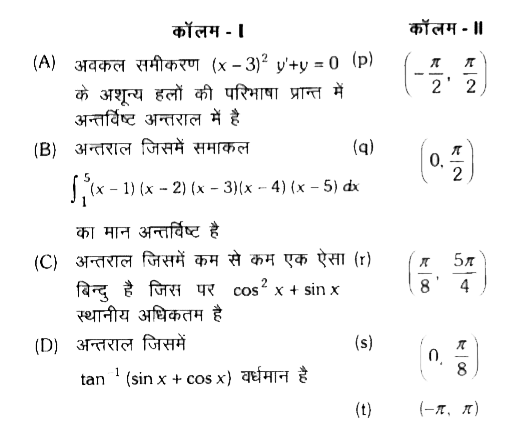यदि f(x)=1+nx+n(n−1)2x2+n(n−1)(n−2)6x3+.....+xn, तब f(1)=
n(n−1)2n−2
n(n−1)2n
n(n−1)2n−1
(n−1)2n−1
The correct Answer is:A
Step by step video, text & image solution for यदि f(x)=1+nx+(n(n-1))/(2)x^(2)+(n(n-1)(n-2))/(6)x^(3)+.....+x^(n), तब f"(1)= by Maths experts to help you in doubts & scoring excellent marks in Class 12 exams.
Updated on:21/07/2023Topper's Solved these Questions
- अवकलन तथा अवकलज के अनुप्रयोगBook:ERRORLESS HINDIChapter:अवकलन तथा अवकलज के अनुप्रयोगExercise:MULTIPLE CHOICE QUESTIONS (आंशिक अवकलन )
Explore 10 Videos
- अवकलन तथा अवकलज के अनुप्रयोगBook:ERRORLESS HINDIChapter:अवकलन तथा अवकलज के अनुप्रयोगExercise:MULTIPLE CHOICE QUESTIONS (यांत्रिकी में अनुप्रयोग व परिवर्तन की दर )
Explore 68 Videos
- अवकलन तथा अवकलज के अनुप्रयोगBook:ERRORLESS HINDIChapter:अवकलन तथा अवकलज के अनुप्रयोगExercise:MULTIPLE CHOICE QUESTIONS (अस्पष्ट फलनों का अवकलन,प्रचलिक व संयुक्त फलनों का अवकलन,लघुगणकीय अवकलन, अनन्त श्रेणियों के अवकलन )
Explore 64 Videos
- अवकल समीकरण Book:ERRORLESS HINDIChapter:अवकल समीकरण Exercise:JEE Advanced ( Matrix Match type questions )
Explore 3 Videos
- केन्द्रीय प्रवृत्ति के मापBook:ERRORLESS HINDIChapter:केन्द्रीय प्रवृत्ति के मापExercise:Jee Advanced (Reasoning )
Explore 2 Videos
Similar Questions
यदि u=log(x3+y3+z3−3xyz) तो (ϑuϑx+ϑuϑy+ϑuϑz)(x+y+z)=
View Solutionएक गोले की त्रिज्या 20 सेमी मापी गयी है तथा संभव त्रुटि 0.02 सेमी है। गोले के पृष्ठ में परिणामी त्रुटि होगी
View Solutionमाना y,x2x−2xxcoty−1=0 से परिभाषित x का एक अस्पष्ट फलन है। तब y'(1) बराबर है
View Solution
View Solutionकथन - 1 : प्रथम n सम धन पूर्णांकों का प्रसरण n2−14 है।
कथन - 2 : प्रथम n धन पूर्णाको का योगफल n(n+1)2 और प्रथम n धन पूर्णांको के वर्गों का योगफल n(n+1)(2n+1)6 है।
View SolutionShow that: (x)+(x+(1)/(n))+(x+(2)/(n))+...+(x+(n-1)/(n))=nx+(n-1)/(2)
View SolutionIf f(x)=xn,f(1)+f1(1)1+f2(1)2!+fn(1)n!,wherefr(x) denotes the rth order derivative of f(x) with respect to x, is n b. 2n c. 2n−1 d. none of these
View Solutionint_(n)^(n+1)f(x)dx=n^(2)+n then int_(-1)^(1)f(x)dx=
View SolutionIf f(x)=(x+1)(x+2)(x+3).x+n then f'(0) is n! (b) n(n+1)2 (n!)(ln n!) (d) n!(1+12+13+14+ .+1n)
View Solutionf(x)=(x+x^(2)+......+x^(n)-n)/(x-1),x!=1 then value of f(1) so that f is continuous is (A) n(B)(n(n-1))/(2) (C) (n(n+1))/(2) (D) (n+1)/(2)
View SolutionIf x=(2+√3)n,n∈N and f=x−[x], then f21−f
View Solutionlim_ (x rarr oo) ((1 ^ ((1) / (x)) + 2 ^ ((1) / (x)) + 3 ^ ((1) / (x)) ++ n ^ ((1 ) / (x))) / (n)) ^ (nx), n in N
View SolutionLet f(x)=x(1+xn)1n for n≥2 and g(x)=fofo…off occurs n times(x). Then ∫xn−2g(x)dx equals (A) 1n(n−1)(1+nxn)1−1n+K (B) 1n−1(1+nxn)1−1n+K (C) 1n(n+1)(1+nxn)1+1n+K (D) 1n+1(1+nxn)1−1n+K
View SolutionIf f(x)=xn,nεN, then the value of f(1)−f′(1)1!+f(1)2!−(f′'')13!+…+(−1)nfn(1)n! is
View SolutionIf f(x)=1+nx+n(n−1)2x2+n(n−1)(n−2)6x3
+...+xn,thenf''(1) is equal to
View Solutionयदि f(x)=xn, तब f(1)−f1(1)1!+f2(1)2!−f3(1)3!+......+(−1)nfn(1)n! का मान है :
View Solution

